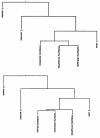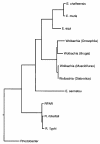Wolbachia: evolutionary novelty in a rickettsial bacteria
- PMID: 11734058
- PMCID: PMC60491
- DOI: 10.1186/1471-2148-1-10
Wolbachia: evolutionary novelty in a rickettsial bacteria
Abstract
Background: Although closely related, the alpha-proteobacteria Wolbachia and the Rickettsiaceae (Rickettsia and Ehrlichia), employ different evolutionary life history strategies. Wolbachia are obligate endocellular symbionts that infect an extraordinary host range and, in contrast to the infectious and pathogenic Rickettsia and Ehrlichia, profoundly influence host reproductive biology.
Results: Phylogenies of the Rickettsia, Ehrlichia, and Wolbachia were independently inferred from 16S rDNA sequences and GroEL amino acid sequences. Topologies inferred from both sets of sequence data were consistent with one another, and both indicate the genus Wolbachia shared a common ancestor most recently with Ehrlichia. These two genera are a sister group to the genus Rickettsia. Mapping biological properties onto this phylogeny reveals that manipulation of host reproduction, characteristic of Wolbachia strains, is a derived characteristic. This evolutionary novelty is accompanied by the loss of the ability to infect vertebrate hosts.
Conclusions: Because of the contrasting transmission strategies employed by each, Wolbachia is expected to maximize efficiency of vertical transmission, while Ehrlichia and Rickettsia will optimize horizontal transfer of infection. Wolbachia manipulation of host reproduction could thus be viewed as strategy employed by this bacterium to foster its own propagation via vertical transmission.
Figures



References
-
- Hackstadt T. The Biology of Rickettsiae. Infectious Agents and Disease. 1996;5:127–143. - PubMed
Publication types
MeSH terms
Substances
LinkOut - more resources
Full Text Sources
Research Materials

